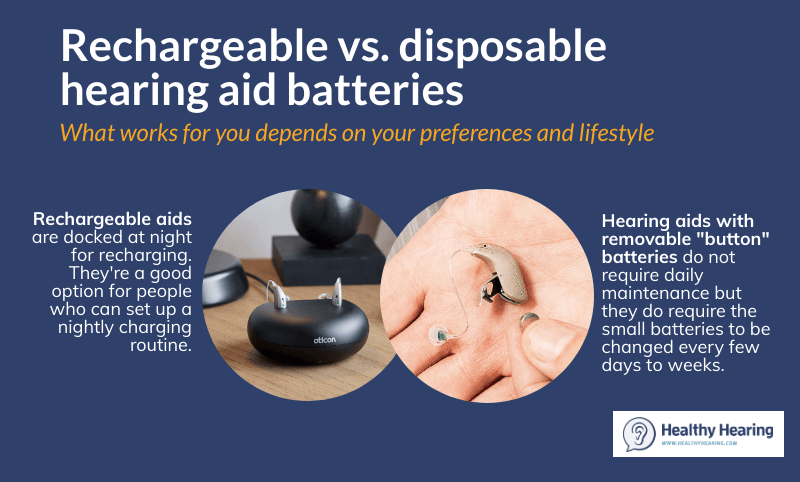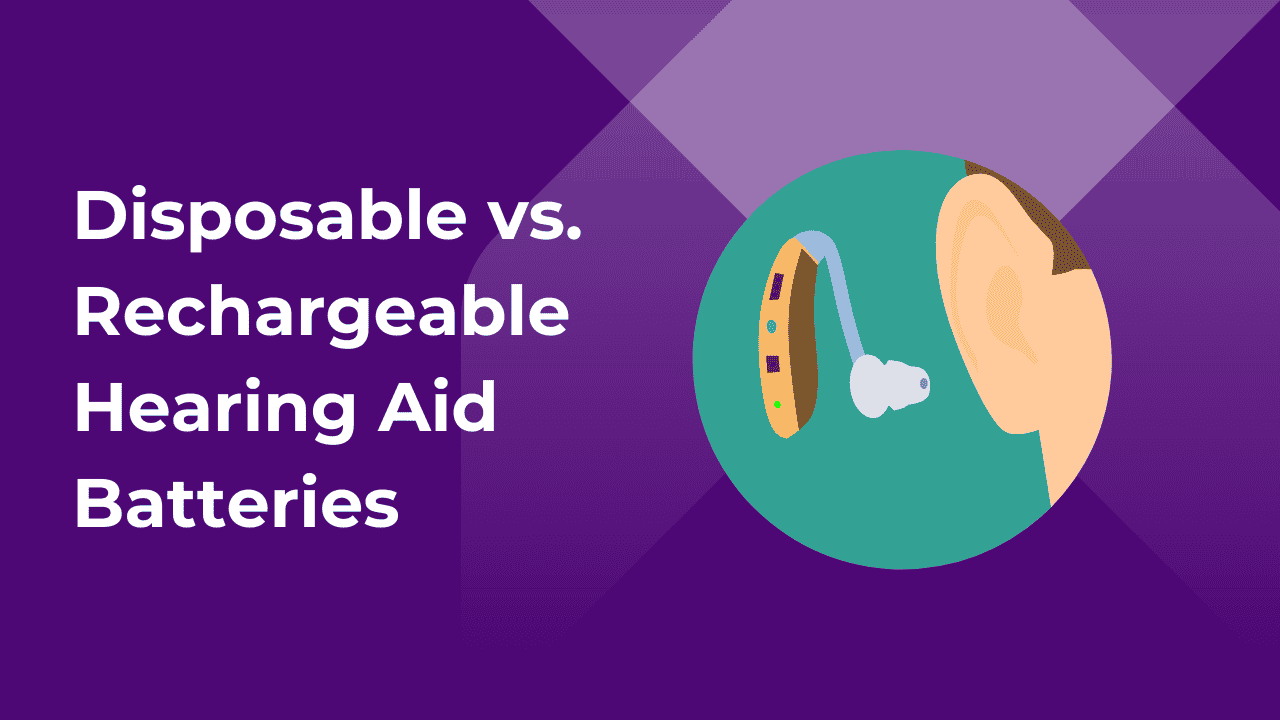Selecting the right hearing aid battery is more than just a technical decision; it’s about enhancing your overall hearing experience. Whether you are a seasoned hearing aid user, considering an upgrade, or purchasing your first device, understanding the nuances of hearing aid batteries is crucial. This guide delves into the intricacies of hearing aid batteries, comparing disposable and rechargeable options, to help you make an informed choice.
Overview of Hearing Aid Batteries
The world of hearing aid batteries is diverse and sometimes complex. Batteries power the small yet sophisticated devices that bring sound clarity and comfort to users. They come in different types and sizes, each with its unique set of advantages and drawbacks. Choosing the right battery type not only impacts the performance of your hearing aids but also affects your daily routine, environmental footprint, and long-term costs.
Importance of Choosing the Right Battery Type
Selecting the correct battery type is paramount. The right battery ensures your hearing aids function optimally, providing consistent sound quality and reliability. Additionally, the choice between disposable and rechargeable batteries can significantly influence your lifestyle, convenience, and financial planning.

Image Source: Healthy Hearing
Understanding Disposable Hearing Aid Batteries
What Are Disposable Hearing Aid Batteries?
Disposable hearing aid batteries are single-use power sources designed specifically for hearing aids. Once they deplete, they must be replaced with new ones. These batteries are typically zinc-air, activated by exposure to air once their protective tab is removed.
Common Types and Sizes
Disposable hearing aid batteries come in standard sizes, including 10, 13, 312, and 675. Each size corresponds to different hearing aid models and power requirements, ensuring compatibility and performance.
Advantages of Disposable Batteries
Convenience and Availability
Disposable batteries are widely available and can be easily purchased from pharmacies, online stores, and specialized retailers. Their small size makes them easy to carry as spares, ensuring you are never caught without power.
Cost-Effectiveness in the Short Term
In the short term, disposable batteries are relatively inexpensive. The low initial cost makes them an attractive option for many users, especially those new to hearing aids or those who prefer not to invest heavily upfront.
Disadvantages of Disposable Batteries
Environmental Impact
The environmental footprint of disposable batteries is significant. Their single-use nature contributes to waste generation, with millions of batteries ending up in landfills annually. This raises concerns about sustainability and environmental stewardship.
Frequent Replacement and Management
Disposable batteries require regular replacement, often every few days to a couple of weeks, depending on usage and hearing aid type. Managing these frequent changes can be cumbersome and inconvenient, especially for users with dexterity issues.
Exploring Rechargeable Hearing Aid Batteries
What Are Rechargeable Hearing Aid Batteries?
Rechargeable hearing aid batteries are designed for repeated use. They can be recharged multiple times, providing a sustainable and eco-friendly power solution. These batteries are typically built into the hearing aid or provided as replaceable units.
Different Types of Rechargeable Batteries
Lithium-Ion Batteries
Lithium-ion batteries are known for their high energy density and long life. They are commonly used in modern hearing aids, offering reliable performance and ease of use.
Silver-Zinc Batteries
Silver-zinc batteries provide a high energy capacity and are often used in premium hearing aids. They are also recyclable, adding to their eco-friendly credentials.
Benefits of Rechargeable Batteries
Long-Term Cost Savings
Although the initial investment is higher, rechargeable batteries can save money in the long run. Their longevity reduces the need for frequent purchases, making them a cost-effective choice over time.
Eco-Friendly Choice
Rechargeable batteries significantly reduce waste, contributing to a smaller environmental footprint. By opting for rechargeable options, users can align their hearing aid use with broader sustainability goals.
Ease of Use and Maintenance
Rechargeable batteries eliminate the need for constant replacements. Users can recharge their hearing aids overnight, ensuring they are ready for use each day. This ease of use simplifies daily routines and reduces maintenance hassles.
Potential Drawbacks of Rechargeable Batteries
Initial Investment
The upfront cost of rechargeable hearing aids and their batteries can be a barrier for some users. However, this should be weighed against the long-term savings and environmental benefits they offer.
Charging Requirements and Availability
Rechargeable batteries require access to charging facilities. While charging stations are generally compact and portable, users must plan for charging, especially during travel or extended periods away from home.
Comparing Performance and Longevity
Battery Life: Disposable vs. Rechargeable
Typical Lifespan of Disposable Batteries
Disposable batteries typically last between 3 to 14 days, depending on their size and the power consumption of the hearing aid. Regular replacements are necessary to maintain optimal performance.
Expected Lifespan of Rechargeable Batteries
Rechargeable batteries can last for several years, with daily recharging. The exact lifespan varies by battery type and usage patterns but generally ranges from 1 to 5 years.
Reliability and Consistency in Performance
How Disposable Batteries Fare in Different Conditions
Disposable batteries can be affected by environmental conditions such as humidity and temperature. These factors can influence their lifespan and performance, requiring users to be mindful of storage and usage conditions.
Performance of Rechargeable Batteries Over Time
Rechargeable batteries tend to provide consistent performance over their lifespan. However, like all rechargeable devices, their capacity may diminish over time, necessitating eventual replacement.
User Experience and Convenience
Daily Management and Routine
Managing disposable batteries involves keeping track of replacements and carrying spares. Rechargeable batteries simplify this process, requiring only a nightly recharge.
Travel and On-the-Go Considerations
For frequent travelers, rechargeable batteries offer convenience and peace of mind. A single charger can replace the need for carrying multiple spare batteries, simplifying travel logistics.
Cost Analysis: Short-Term vs. Long-Term Investment
Initial Costs: Disposable vs. Rechargeable
Disposable batteries have a lower initial cost, while rechargeable batteries require a higher upfront investment. However, the long-term financial benefits of rechargeable options can offset this initial expense.
Ongoing Costs and Budgeting
Frequency of Replacing Disposable Batteries
Frequent replacements mean ongoing costs for disposable batteries. Users need to budget for regular purchases, which can add up over time.
Lifespan and Replacement of Rechargeable Batteries
Rechargeable batteries, while more expensive initially, offer lower ongoing costs. Their extended lifespan reduces the frequency of replacements, providing financial relief in the long run.
Total Cost of Ownership Over Time
Breaking Down Long-Term Expenses
Over several years, the total cost of ownership for rechargeable batteries is often lower than for disposable batteries. This includes initial costs, replacement expenses, and potential savings from reduced waste management.
Considering Hidden Costs and Savings
Hidden costs, such as environmental impact and convenience, also play a role in the overall cost analysis. Rechargeable batteries often come out ahead when these factors are considered.
Environmental Impact and Sustainability
Environmental Footprint of Disposable Batteries
Disposable batteries contribute significantly to waste generation. Each spent battery adds to landfill burden, creating environmental concerns.
Waste Generation and Disposal Issues
The disposal of used batteries poses environmental hazards, including potential soil and water contamination from battery chemicals.
Recycling Challenges and Solutions
Recycling disposable batteries is challenging due to the complexity and cost of the process. However, proper disposal and recycling can mitigate some environmental impacts.
Eco-Friendly Aspects of Rechargeable Batteries
Reduction in Waste and Pollution
Rechargeable batteries reduce the number of batteries discarded, lowering overall waste and pollution. This contributes to a healthier environment.
Advances in Battery Recycling Technology
New technologies are improving the recycling of rechargeable batteries, making them an even more sustainable choice.
Making an Informed, Sustainable Choice
Aligning Personal Values with Battery Selection
Choosing between disposable and rechargeable batteries can reflect personal values regarding environmental stewardship and sustainability.
Supporting Eco-Friendly Innovations in Hearing Aids
Opting for rechargeable batteries supports the development and adoption of eco-friendly technologies in the hearing aid industry.
User Preferences and Lifestyle Considerations
Assessing Your Daily Routine and Needs
Consider your daily activities, work, and social engagements when choosing a battery type. Your lifestyle can significantly influence which option is more convenient and effective for you.
Active vs. Sedentary Lifestyle Implications
Active lifestyles may benefit more from the convenience of rechargeable batteries, while a sedentary routine may find the frequent replacements of disposable batteries manageable.
Impact of Work and Social Activities
Your work environment and social life also play a role. Busy professionals and socially active individuals may prefer the hassle-free nature of rechargeable batteries.
Personal Comfort and Ease of Use
Handling and Replacing Batteries
Ease of handling is crucial, especially for individuals with dexterity issues. Rechargeable batteries reduce the need for frequent handling and replacement.
Familiarity with Technology and Devices
Comfort with technology can influence your choice. Rechargeable batteries often come with modern hearing aids that require a certain level of tech-savviness.
Seeking Professional Advice and Recommendations
Consulting Audiologists and Hearing Aid Specialists
Professional advice from audiologists can provide personalized recommendations based on your hearing needs and lifestyle.
Reading Reviews and User Experiences
User reviews and experiences offer valuable insights into the practical aspects of using disposable and rechargeable batteries.
Conclusion
Summarizing the Pros and Cons
Choosing the right hearing aid battery involves weighing the pros and cons of disposable and rechargeable options. Each has its unique benefits and drawbacks, influencing performance, cost, and environmental impact.
Encouraging Informed Decisions Based on Individual Needs
Making an informed decision requires considering your specific needs, lifestyle, and values. Both battery types have their place, and the right choice depends on your individual circumstances.
Future Trends in Hearing Aid Battery Technology
The future holds promising advancements in hearing aid battery technology, aiming for longer life, better performance, and enhanced sustainability. Staying informed about these trends can help you make better choices as technology evolves.





